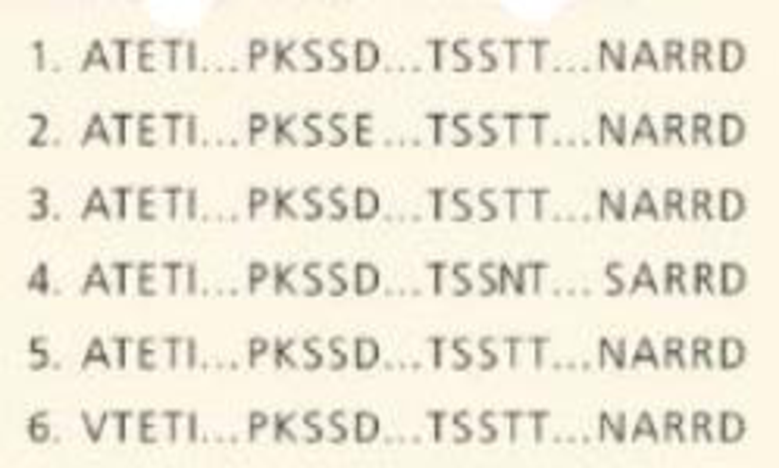
Campbell Biology: Custom Edition
18th Edition
ISBN: 9781323717271
Author: Urry, Cain, Wasserman, Minorsky, Reece
Publisher: PEARSON C
expand_more
expand_more
format_list_bulleted
Textbook Question
Chapter 21, Problem 4TYU
DRAW IT Below are the amino acid sequences(using the single-letter code; see Figure 5.14) of four short segments of the FOXP2 protein from six Speeles: chimpanzce (Q, orangutan (()), gorllla (G), rhesus macaque (R), mouse (M), and human (H). These segments contain all of the amino acid differences helween the FOXP2 proteinsof these species.

Use a highlighter to color anv amino acid that varies among the species. (Color that amino acid in all sequences.
- (a) The C, G, R sequences are identical. Identily which lines correspond to those sequences.
- (b) The O sequence differs from the C, G, R speieces at two amino acids. Underilnethetwodlffcrences inthe H sequence.
- (c) The O sequence diffen from the C, G, R sequences at one amino acid (having V instead of A) and from the H sequence at three amino acids. Identify tho O sequence.
- (d) In the M sequence,circle the amino acid(s) that differ from the C, G, R sequence, and draw a square around those that differ from the H sequence.
- (e) Primates and rodents diverged between 60 and IO0 million years ago. and chimpanzees and humans about 6 million years ago. Compare the amino acid differences between the mouse and the C, G, R species with those between the human and the C, G, R species. What can you conclude?
Expert Solution & Answer
Learn your wayIncludes step-by-step video

schedule09:19
Students have asked these similar questions
Answer Question 1-9
Ex: Mr. Mandarich wanted to see if the color of light shined on a planthad an effect on the number of leaves it had. He gathered a group ofthe same species of plants, gave them the same amount of water, anddid the test for the same amount of time. Only the color of light waschanged.
IV:DV:Constants:Control Gr:
ethical considerations in medical imaging
Chapter 21 Solutions
Campbell Biology: Custom Edition
Ch. 21.1 - Describe the whole-genome shotgun approach.Ch. 21.2 - Prob. 1CCCh. 21.2 - Explain the advantage of the systems biology...Ch. 21.2 - MAKE CONNECTIONS The ENCODE pilot project found...Ch. 21.2 - MAKE CONNECTIONS In Concept 20.2, you learned...Ch. 21.3 - The best estimate is that the human genome...Ch. 21.3 - The Genomes Online Database (GOLD) Website of the...Ch. 21.3 - WHAT IF? What evolutionary processes might...Ch. 21.4 - Discuss the characteristics of mammalian genomes...Ch. 21.4 - VISUAL SKILLS Which of the three mechanisms...
Ch. 21.4 - Contrast the organizations of the rRNA gene family...Ch. 21.4 - MAKE CONNECTIONS Assign each DNA segment at the...Ch. 21.5 - Describe three examples of errors in cellular...Ch. 21.5 - Explain how multiple exons might have arisen in...Ch. 21.5 - What are three ways that transposable elements are...Ch. 21.5 - WHAT IF? In 2005, Icelandic scientists reported...Ch. 21 - How did the Human Genome Project result in more...Ch. 21 - What has been the most significant finding of the...Ch. 21 - Compare genome size, gene number, and gene density...Ch. 21 - Explain how the function of transposable elements...Ch. 21 - How could chromosomal rearrangements lead to the...Ch. 21 - What type of Information can be obtained by...Ch. 21 - Bioinformatics intludes all of the following...Ch. 21 - Homeotic genes (A) encode transcription factors...Ch. 21 - Prob. 3TYUCh. 21 - DRAW IT Below are the amino acid sequences(using...Ch. 21 - EVOLUTION CONNECTION Genes important in the...Ch. 21 - scientific inquiry The scientists mapping the SNPs...Ch. 21 - Prob. 7TYUCh. 21 - SYNTHESIZE YOUR KNOWLEDGE Insects have three...
Additional Science Textbook Solutions
Find more solutions based on key concepts
Explain all answers clearly, with complete sentences and proper essay structure if needed. An asterisk (*) desi...
Cosmic Perspective Fundamentals
27. Consider the reaction.
Express the rate of the reaction in terms of the change in concentration of each of...
Chemistry: Structure and Properties (2nd Edition)
Two culture media were inoculated with four different bacteria. After incubation, the following results were ob...
Microbiology: An Introduction
Which one of the following is not a fuel produced by microorganisms? a. algal oil b. ethanol c. hydrogen d. met...
Microbiology: An Introduction
95. What is the minimum amount of necessary to produce 15.0 g of according to the reaction:
...
Introductory Chemistry (6th Edition)
Johnny was vigorously exercising the only joints in the skull that are freely movable. What would you guess he ...
Anatomy & Physiology (6th Edition)
Knowledge Booster
Similar questions
- Please correct answer and don't used hand raiting and don't used Ai solutionarrow_forward2. In one of the reactions of the citric acid cycle, malate is oxidized to oxaloacetate. When this reaction is considered in isolation, a small amount of malate remains and is not oxidized. The best term to explain this is a. enthalpy b. entropy c. equilibrium d. free energy e. loss of energyarrow_forward18. The citric acid cycle takes place in a. the chloroplasts b. the cytosol c. the inner mitochondrial membrane d. between the two mitochondrial membranes e. the mitochondrial matrix 40 WILarrow_forward
- 8. Most reactions of anaerobic respiration are similar to a. aerobic respiration b. photosynthesis c. lactic acid fermentation d. alcoholic fermentation e. both c and darrow_forward12. Which of the following molecules can absorb light? a. Pigments b. Chlorophyll c. Rhodopsin d. Carotenoids e. All of the abovearrow_forwardWhich of the following proteins or protein complexes is directly required for the targeting of mitochondrial inner membrane multipass proteins, such as metabolite transporters, whose signal sequence is normally not cleaved after import? OA. TIM22 OB. TIM23 C. OXA OD. Mia40 OE SAMarrow_forward
- QUESTION 9 An animal cell has been wounded and has a small rupture in its plasma membrane. Which of the following is more likely to happen next? OA. The cell rapidly cleaves by cytokinesis. OB. The rate of receptor-mediati endocytosis is increased. OC. The rate of exocytosis is increased. OD. The rate of pinocytosis is increased.arrow_forwardFor the a subunit of a trimeric G protein, A. a G-protein-coupled receptor GPCR) acts as a guanine nucleotide exchange factor (GEF), whereas a regulator of G protein signaling (RGS) can act as a GTPase-activating protein (GAP). B. a GPCR acts as a GAP, whereas an RGS can act as a GEF. C. both a GPCR and an RGS can act as a GEF. O D. both a GPCR and an RGS can act as a GAP OE. None of the above.arrow_forwardA cell expresses a transmembrane protein that is cleaved at the plasma membrane to release an extracellular fragment. The fragment binds to receptor proteins on nearby cells and activates signaling pathways resulting in altered gene expression patterns in the cells. What form of intercellular signaling does this represent? OA. Contact-dependent signaling B. Paracrine signaling OC. Synaptic signaling D. Endocrine signaling E. Autocrine signalingarrow_forward
- Which of the following drive nuclearly encoded proteins import into the mitochondrial matrix? OA. ATP hydrolysis OB. Membrane Potential OC. K+ Ions OD. A and B OE. None of the abovearrow_forwardWhich of the following statements is true regarding Cholesterol import into the cell? OA. It is transported within LDL B. Receptor mediated endocytosis is involved OC. Release of cholesterol occurs in the Lysosome D. All of the above are true statements OE. None of the above are true statementsarrow_forwardIn which of the following schematic drawings of signaling pathways does the activation of the receptor lead to gene expression? Activating and inhibitory steps are indicated with (+) and (-), respectively. OA OB ㅇㅂㅇㅂㅇㅁ (+) Gene Expression Activated Signaling proteins Transcription receptor activator Bl D Gene Expression Gene Expression ㅁㅁㅇ Gene Expression Gene Expressionarrow_forward
arrow_back_ios
SEE MORE QUESTIONS
arrow_forward_ios
Recommended textbooks for you
 Biology: The Dynamic Science (MindTap Course List)BiologyISBN:9781305389892Author:Peter J. Russell, Paul E. Hertz, Beverly McMillanPublisher:Cengage Learning
Biology: The Dynamic Science (MindTap Course List)BiologyISBN:9781305389892Author:Peter J. Russell, Paul E. Hertz, Beverly McMillanPublisher:Cengage Learning Biology Today and Tomorrow without Physiology (Mi...BiologyISBN:9781305117396Author:Cecie Starr, Christine Evers, Lisa StarrPublisher:Cengage Learning
Biology Today and Tomorrow without Physiology (Mi...BiologyISBN:9781305117396Author:Cecie Starr, Christine Evers, Lisa StarrPublisher:Cengage Learning Human Heredity: Principles and Issues (MindTap Co...BiologyISBN:9781305251052Author:Michael CummingsPublisher:Cengage Learning
Human Heredity: Principles and Issues (MindTap Co...BiologyISBN:9781305251052Author:Michael CummingsPublisher:Cengage Learning BiochemistryBiochemistryISBN:9781305577206Author:Reginald H. Garrett, Charles M. GrishamPublisher:Cengage Learning
BiochemistryBiochemistryISBN:9781305577206Author:Reginald H. Garrett, Charles M. GrishamPublisher:Cengage Learning Concepts of BiologyBiologyISBN:9781938168116Author:Samantha Fowler, Rebecca Roush, James WisePublisher:OpenStax College
Concepts of BiologyBiologyISBN:9781938168116Author:Samantha Fowler, Rebecca Roush, James WisePublisher:OpenStax College

Biology: The Dynamic Science (MindTap Course List)
Biology
ISBN:9781305389892
Author:Peter J. Russell, Paul E. Hertz, Beverly McMillan
Publisher:Cengage Learning

Biology Today and Tomorrow without Physiology (Mi...
Biology
ISBN:9781305117396
Author:Cecie Starr, Christine Evers, Lisa Starr
Publisher:Cengage Learning

Human Heredity: Principles and Issues (MindTap Co...
Biology
ISBN:9781305251052
Author:Michael Cummings
Publisher:Cengage Learning

Biochemistry
Biochemistry
ISBN:9781305577206
Author:Reginald H. Garrett, Charles M. Grisham
Publisher:Cengage Learning

Concepts of Biology
Biology
ISBN:9781938168116
Author:Samantha Fowler, Rebecca Roush, James Wise
Publisher:OpenStax College
